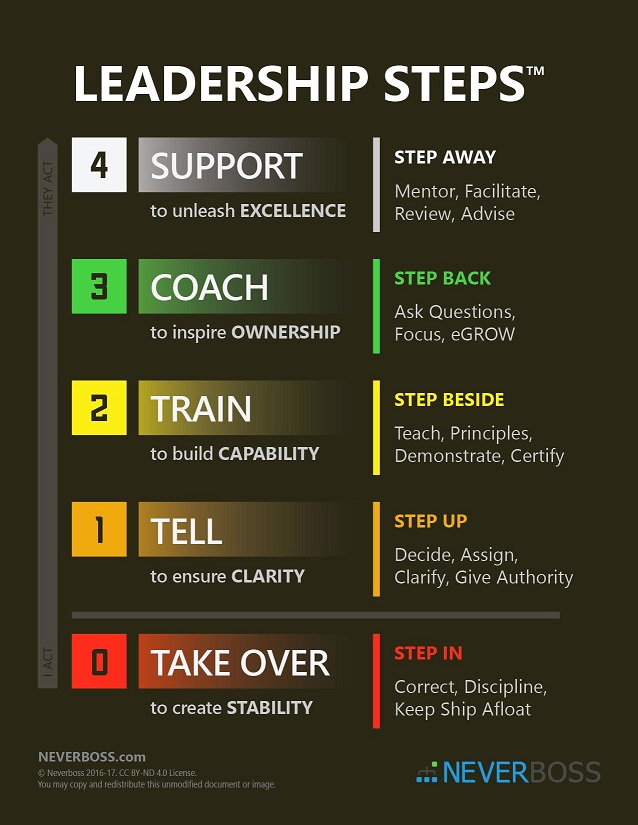“I feel guilty.” The seasoned tech lead paused. He explained to me that the Ladder of Leadership, from David Marquet’s intent-based leadership model, resonated with him. He wanted to be a Level 5 leader. He wanted to empower the younger engineers he was mentoring.
But he couldn’t.
The younger engineers just didn’t have the technical competence or experience needed for them to be able to make good decisions (or even mediocre ones).
He wanted to be a Level 5 leader and was feeling guilty because he couldn’t figure out how not to be a Level 1 leader.
Ladder of Leadership
| Level 7 | I have been doing… | What have you been doing? |
| Level 6 | I did… | What have you done? |
| Level 5 | I intend to… | What do you intend to do? |
| Level 4 | I would like to… | What would you like to do? |
| Level 3 | I think… | What do you think? |
| Level 2 | I observe … | What do you observe? |
| Level 1 | Tell me what to do | I’ll tell you what to do |
I teach the Ladder of Leadership quite often. When we listen for the phrases and variants of the levels we can evaluate our own leadership level as well as the leadership level of those around us. If we are in a leadership role, assessing the leadership level of those we’re leading is a key first step in growing their level of leadership.
When we hear, “Tell me what to do”, we can reply, “What do you observe about the situation we’re in?” The idea is to move people up the ladder by using the language of the next level to challenge them into exploring and expressing their potential.
But what if that’s not working? What if there isn’t an answer to “What do you see?” This is the situation my tech lead friend was in.
Empowering Leadership Model
A different, complimentary model gave our tech lead permission to approach the situation differently. This is the Empowering Leadership Model, from Kevin Crenshaw’s book, Neverboss.

At Step 0, the situation is such that the leader has to step in and take control. The idea is that this is a temporary measure to keep from failing altogether.
In Step 1, the leader steps up and ensures clarity. Clarity of organizational goals and mission at hand is one of the two pillars supporting empowerment in intent-based leadership.
In Step 2 of the Empowering Leadership Model the leader steps beside and focuses on training. Technical competence is the second pillar supporting empowerment.
We may be able to use the questions of Levels 2, 3, and 4 in the Ladder of Leadership to assess how ready a team member is to be empowered to make decisions. If they are lacking clarity or technical competence, the leader can use Steps 1 and 2 to fill the gaps.
At Step 3 of the Empowering Leadership Model, the leader transitions into coaching and steps back. This allows the team member to start taking ownership of the work. Level 5 on the Ladder, “I intend” is all about psychological ownership. It’s difficult to sincerely say the words “I intend to” without having thought through the problem and solution, thus taking ownership of the action.
However, just because you state your intention doesn’t mean you will have chosen the right path 100% of the time. You may not have all the information, or the experience needed to choose the best action. Feedback and coaching from the leader is required to get it right. And, with the feedback and coaching, a team member is learning what’s important to the leader, and preparing themselves for their leader’s higher level of responsibility.
Step 4 of the empowering leadership model is where the leader steps away into a support role. They review, mentor, and advise when asked. At this point this team may be at Level 5, 6, or 7 on the Ladder of Leadership.
In summary, no need to feel guilty about wanting to be a Level 5 leader but not seeing how that’s possible. We just need to supplement the Ladder of Leadership with the Empower Leadership Steps!
tl;dr
The Ladder of Leadership is a great tool, but doesn’t give us the steps we need to consider on the journey to empowerment. The Empowering Leadership Model fills in that gap. It provides the steps to fortify the two pillars that support empowerment, clarity and technical competence, as well as steps that result in moving team members up the Ladder of Leadership.
engineer your life
- If you’re a leader, determine where you and your team members are on the Ladder of Leadership. Determine which leadership steps in the Empowering Leadership Model would help team members climb the Ladder of Leadership.
- If you’re a team member, evaluate where you are on the Ladder of Leadership. Look at the Empowering Leadership Model, and ask for help with any of the steps to help you increase your leadership level.